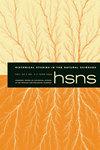跨网络和内部网络
IF 0.3
3区 哲学
Q2 HISTORY & PHILOSOPHY OF SCIENCE
引用次数: 0
摘要
在这篇文章中,我们反思了之前论文的发现如何使我们能够丰富基因组学的历史。我们已经扩展了我们的历史工作所跨越的维度的数量,超出了时间维度的扩展。在此基础上,我们认为基因组学的历史与一系列群落、目标物种和研究议程同步纠缠在一起,其中包括酵母生物化学、猪和人类免疫学、系统学、医学遗传学和农业遗传学。我们用分析范畴来理解这些纠缠,以表征组织和进行测序的模式,以及测序实践与周围协作目标之间的关系:水平和垂直,近端和远端,有向和无向,以及密集和广泛测序。我们的分类是在分析和定性解释数据集和合著者网络时出现的。在这期特刊中,我们将基因组学描述为一套工具,它打开了参与者、机构、实验生物体和历史上偶然的研究形式之间的联系。我们认为,以这种方式呈现基因组学强调了动员序列数据的社区机构,并为解决该数据的医学和农业翻译提供了新的视角。最后,我们提出了如何通过建立一个领域本体来发展我们的混合方法方法,该领域本体将允许序列提交和出版物的信息与其他形式的数据相连接,从而扩大了可用于历史分析的证据范围。这篇文章是由Michael García-Sancho和James Lowe编辑的题为“序列和测序者:研究酵母、人类和猪基因组学出现的新方法”的特刊的一部分。本文章由计算机程序翻译,如有差异,请以英文原文为准。
Across and within Networks
In this essay, we reflect on how the findings of the preceding papers enabled us to thicken the history of genomics. We have expanded the number of dimensions across which our historical work operated beyond extending the dimension of time. Building on this, we argue that the history of genomics became synchronically entangled with a range of communities, target species, and research agendas—among them yeast biochemistry, pig and human immunology, systematics, medical genetics, and agricultural genetics. We make sense of these entanglements with analytic categories to characterize modes of organizing and conducting sequencing, and the relationships between the practices of sequencing and the objectives of those collaborating around it: horizontal and vertical, proximate and distal, directed and undirected, as well as intensive and extensive sequencing. Our categories emerged as we analyzed and qualitatively interpreted datasets and co-authorship networks. Throughout this special issue, we have characterized genomics as a set of tools that open up connections between actors, institutions, experimental organisms, and historically contingent forms of research. We contend that presenting genomics in this way emphasizes the agency of the communities that mobilized the sequence data and offers a fresh perspective for addressing the medical and agricultural translation of that data. We close by proposing how we can develop our mixed-methods approach through the establishment of a domain ontology that would allow information on sequence submissions and publications to be connected to other forms of data, thus expanding the range of evidence available for historical analysis. This essay is part of a special issue entitled The Sequences and the Sequencers: A New Approach to Investigating the Emergence of Yeast, Human, and Pig Genomics, edited by Michael García-Sancho and James Lowe.
求助全文
通过发布文献求助,成功后即可免费获取论文全文。
去求助
来源期刊

Historical Studies in the Natural Sciences
社会科学-科学史与科学哲学
CiteScore
1.00
自引率
0.00%
发文量
24
审稿时长
>12 weeks
期刊介绍:
Explore the fascinating world of Historical Studies in the Natural Sciences, a journal that reveals the history of science as it has developed since the 18th century. HSNS offers in-depth articles on a wide range of scientific fields, their social and cultural histories and supporting institutions, including astronomy, geology, physics, genetics, natural history, chemistry, meteorology, and molecular biology. Widely regarded as a leading journal in the historiography of science and technology, HSNS increased its publication to five times per year in 2012 to expand its roster of pioneering articles and notable reviews by the most influential writers in the field.
 求助内容:
求助内容: 应助结果提醒方式:
应助结果提醒方式:


